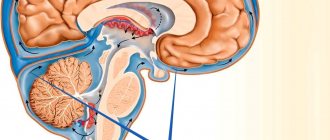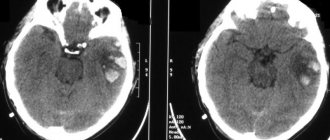Vascular diseases of the brain
The brain (cerebrum)
is an organ of the central nervous system, consisting of many interconnected nerve cells and their processes.
Vascular diseases of the brain are recognized in medicine as one of the most dangerous groups of diseases, as they have quite serious consequences for the body. Each cerebral vascular disease has characteristic features that depend on which specific vessels are affected by the pathological process. But in any case, doctors at OKB No. 1 warn that diseases in this group can provoke a hemorrhagic or ischemic stroke, after which the patient either becomes disabled or dies.
Clinical manifestations of vascular diseases of the brain can be divided into the following forms:
- chronic cerebral ischemia stage I-II;
- cerebral circulatory disorder of a transient nature;
- cerebral infarction (ischemic stroke);
- bleeding in the brain (hemorrhagic stroke).
Causes of cerebrovascular diseases:
The occurrence of cerebrovascular diseases occurs as follows: insufficient blood supply limits the access of oxygen and glucose, resulting in a cerebral infarction, the results of which are unpredictable. In adulthood, vascular atherosclerosis and hypertension can negatively affect blood supply.
Treatment of vascular diseases of the brain:
Among the many diseases of the cerebral vessels, coronary disease and discirculatory encephalopathy deserve special attention.
Treatment of ischemic disease involves:
- work on restoring impaired physiological and behavioral functions, for which restorative therapy, magnetic and electrophoresis, physical therapy, and massage are used;
- stabilization of blood pressure and prevention of strokes with the help of anticoagulant and vasodilator drugs;
- normalization of metabolism and proper blood circulation. The best results are ensured by taking medications according to medical prescriptions.
Vegetative vascular dystonia
Vegetative-vascular dystonia is a disturbance in the functioning of the body’s vascular system, leading to insufficient oxygen supply to tissues and organs. Otherwise, this disease is called neurocirculatory dystonia, or cardiac neurosis.
Causes of VSD:
- Exhaustion of the body due to acute or chronic infectious diseases or intoxications.
- Sleep disturbances such as insomnia, early awakening or difficulty falling asleep.
- Chronic fatigue, depressed mood, depression.
- Irregular unbalanced diet.
- Excessive physical activity or physical inactivity.
- Hormonal changes in the body during puberty in adolescents, pregnancy or menopause in women.
- Change of climate or time zone.
Types of vegetative vascular dystonia:
With a more accurate diagnosis, three types of vegetative-vascular dystonia are distinguished:
- if, with general signs of fatigue, you sometimes have a feeling of lack of air, you complain of irregular heartbeats, then this is vegetative-vascular dystonia of the cardiac type;
- The hypotensive form of vegetative vascular dystonia is characterized by low blood pressure, general weakness, headaches, coldness of the fingers and toes, and a tendency to faint;
- periodic surges in blood pressure indicate hypertensive vegetative-vascular dystonia.
Diagnosis of VSD:
The diagnosis of vegetative-vascular dystonia is made only after a comprehensive examination of the patient and the exclusion of other pathologies that have similar manifestations to VSD.
The list of diagnostic measures includes:
- Laboratory research of general blood test, biochemical composition of plasma, coagulation indicators, hormone levels. If necessary, urine tests are performed. Most often, the indicators of these studies do not go beyond normal values.
- Functional techniques, including ultrasound examination of internal organs and blood vessels of the head and neck, ECG, monitoring of blood pressure levels.
- X-ray of the spinal column, tomography of the brain and spinal cord.
- Consultations with specialists in related specialties.
Only after confirming the absence of other diseases can a diagnosis of vegetative-vascular dystonia be made.
Treatment of vegetative-vascular dystonia:
The majority of patients with VSD do not require drug therapy. The basis of treatment for them is methods aimed at changing the patient’s lifestyle and normalizing the functioning of the nervous system. Physiotherapeutic methods are mainly used to treat the disease. This could be hydromassage, physical therapy. If the symptoms of vegetative-vascular dystonia are serious, acupuncture, manual therapy, and herbal medicine give good results. Vegetative-vascular dystonia responds well to treatment. The main thing is not to self-medicate. The choice of methods by which to treat vegetative vascular dystonia should be determined only by a doctor after conducting the necessary research. Often, VSD “masks” another disease, so its treatment should be aimed primarily at eliminating the underlying disease. And, of course, first of all, don’t bring yourself to the point of needing to see a doctor: try to avoid stressful situations and emotional breakdowns, and, if possible, take a few days of rest and spend them as you would like for a long time. Thus, treatment of vegetative vascular dystonia should be based on both drug therapy and regulation of the mental state.
Symptoms of vascular diseases of the brain
Among the first signs of the disease are chronic headaches, memory loss, decreased hearing and vision, impaired movement, and dizziness.
Discirculatory encephalopathy, that is, a functional disorder of the brain that causes poor blood circulation, is characterized by special symptoms. In the first stages of the disease, the patient experiences emotional instability, chronic fatigue, irritation, dullness of attentiveness, headaches after overexertion (not only physical, but also mental). As a rule, symptoms are more pronounced in the evenings. In the later stages of dyscirculatory encephalopathy, the patient ceases to adequately assess his own condition, feels unsure of his abilities, and loses the ability to think in abstract concepts. At the same time, energy depletion occurs, depriving a person of the opportunity to independently cope with everyday tasks, opting for simpler actions. Hypochondria, a panicky fear of getting sick, is often noted.
Clinical manifestations of vascular diseases of the brain can be divided into the following forms:
- chronic cerebral ischemia stage I-II;
- cerebral circulatory disorder of a transient nature;
- cerebral infarction (ischemic stroke);
- bleeding in the brain (hemorrhagic stroke).
Vascular diseases of the spinal cord
The spinal cord (Medulla spinalis)
is an organ of the central nervous system, consisting of nerve cells and fibers and located in the spinal canal. It starts from the brain and ends in the vertebrae of the lumbar spine and is a long cord, shaped like a cylinder.
It consists of gray matter, which is surrounded on all sides by white matter. The gray matter is predominantly nerve cells, and the white matter is the processes of nerve cells. Spinal cord damage can be caused by various factors. Diseases of the brain and spinal cord, as well as other lesions of its various parts can cause sensory, motor and autonomic disorders. The length of the adult spinal cord ranges from 41 to 45 cm. The spinal cord regulates the functions of the entire body by transmitting nerve impulses to all internal organs.
The human spinal cord can be divided into 5 sections:
-cervical, thoracic, lumbar, sacral, coccygeal. Syndromes of spinal cord lesions differ at different levels, and also depending on which substance is affected, gray or white.
Myelitis
Myelitis
is an inflammation of the spinal cord. The sooner we stop the inflammation, the less the loss of spinal cord substance, the faster the recovery.
Causes and symptoms of myelitis:
Inflammation and destruction of spinal cord tissue leads to a disconnection of communication between the brain and the body, and therefore to:
- sensitivity disorders;
- paresis (paralysis).
Myelitis usually responds well to treatment, you just need to clarify the cause of its occurrence. Therefore, we suggest you conduct research on the following:
- neuroinfections;
- multiple sclerosis;
- disseminated encephalomyelitis.
Diagnosis of myelitis:
- On MRI scans of the spinal cord, foci of inflammation and demyelination are clearly visible.
- Blood tests for antibodies to various infections and rheumatic indicators make it possible to differentiate between neuroinfection and autoimmune inflammation.
- Blood biochemistry data will help identify possible metabolic disorders, which will allow you to select medications correctly.
- A detailed immunogram will allow you to clearly assess the cause of what is happening and select the appropriate treatment for this situation.
- ENMG (electromyography, electroneuromyography, myography) is a set of studies to assess muscle function and the quality of transmission of nerve impulses along peripheral nerves and pathways of the brain and spinal cord. ENMG helps us pinpoint the location of the injury (brain, spinal cord, peripheral nerve or muscle)
Information for patients and their relatives
Rules for hospitalization
Services and prices of the department
Classification of vascular diseases of the brain
There are two main groups of vascular pathologies: acute and chronic cerebrovascular accidents. The first group is divided into three subgroups: transient cerebrovascular accidents, cerebral strokes, mixed strokes. Transient disorders of cerebral circulation include transient ischemic attacks and hypertensive crises. Brain strokes are ischemic and hemorrhagic. Hemorrhagic strokes are divided into subarachnoid hemorrhage, parenchymal-subarachnoid hemorrhage, and ventricular-parenchymal-subarachnoid hemorrhage. Ischemic strokes, in turn, are divided into lacunar, atherothrombotic, cardioembolic and hemodynamic stroke.
The second group includes: chronic subdural hematoma, initial manifestations of cerebrovascular insufficiency, subcortical vascular dementia, discirculatory encephalopathy. The initial manifestations of cerebrovascular insufficiency are divided into two stages. The first stage is characterized by the absence of neurological manifestations. At the second stage, neurological manifestations are clearly expressed. Discirculatory encephalopathy is the most common among chronic cerebrovascular accidents. It is divided into three main stages:
- The first stage is moderately severe, characterized by diffuse symptoms. The patient may complain of short-term headaches, periodically suffer from sleep disorders and increased irritability.
- The second stage is more pronounced; clinical manifestations form in it. The person often experiences surges in blood pressure, loss of space, and cognitive impairment. As a rule, at this stage the disease is most often diagnosed.
- The third stage is pronounced, during which irreversible changes occur in the body. Serious disturbances in memory and cerebral circulation in general appear. In rare clinical situations, complications in the form of strokes are observed (in the absence of timely consultation with a doctor).
Prevention of vascular diseases of the brain
Vascular diseases of the brain are easier to prevent than to cure. To do this, experts recommend leading a healthy lifestyle: engaging in moderate sports, drinking about 1-1.5 liters of water per day (to avoid dehydration), eating properly and following a diet. The diet involves limiting table salt and foods containing large amounts of animal fats (for example, sour cream and fatty meats). Fresh vegetables and fruits should prevail in the daily diet. A split diet is recommended (4-5 meals per day).
The intake of alcoholic beverages should be minimized (or completely abandoned). The emotional component is the key to good health, so you should not be exposed to stressful situations. Sleep should be complete (at least 7 hours of sleep per day are required). Moderate physical activity should be regular; it significantly improves the condition of the body. These include: swimming, yoga, Pilates, cycling.
Exercising and proper nutrition help prevent the appearance of excess weight, while they train the cardiovascular system. At least once a year it is required to undergo a study of the state of cerebral circulation (especially for those who are at risk). This will allow timely detection of pathology.
In order to prevent the progression of multi-infarction conditions, patients are prescribed combination therapy (antiplatelet and anticoagulant). The most suitable anticoagulants are selected depending on blood clotting parameters. If any signs of bleeding appear, it is important to contact a specialist promptly.
Vascular diseases of the brain are often accompanied by dizziness. To prevent them, doctors prescribe medications that affect the autonomic nervous system. To prevent cognitive impairment (memory deterioration, increased inattention), drugs that improve metabolism are prescribed. In the presence of movement disorders, therapeutic exercises, physiotherapy, massage and other methods of rehabilitation therapy are useful.
Vascular diseases of the central nervous system
The central nervous system is the connecting link between all human organs and is responsible for their coordinated functioning. The central nervous system is responsible for the sensitivity and motor activity of the body. Problems in the functioning of the central nervous system cause disruption of the productive functioning of systems and organs. Most vascular diseases are associated with cerebrovascular accidents. They often lead to disability. This class of diseases is the greatest problem of modern medicine.
For the brain to function, it needs a lot of blood (up to 14% of all circulating in the body) and oxygen (up to 20%). Failure of blood supply provokes great difficulties in the functioning of the brain, and a complete break for 5-8 minutes. causes irreversible changes. At normal systolic pressure (60-180 mm Hg), blood flow is stable. With pathologies (high blood pressure, head injury, tumors) and other problems, problems with blood supply begin.
Vascular diseases of the brain include:
- Chronic cerebrovascular insufficiency, including encephalopathy.
- Acute cerebral circulatory disorders (transient, as well as two types of strokes).
- Anomalies of cerebral vessels (aneurysms, disorders of venous and spinal circulation).
Vascular diseases of the central nervous system can be provoked by diabetes mellitus, cervical osteochondrosis, hypertension, and atherosclerosis.










